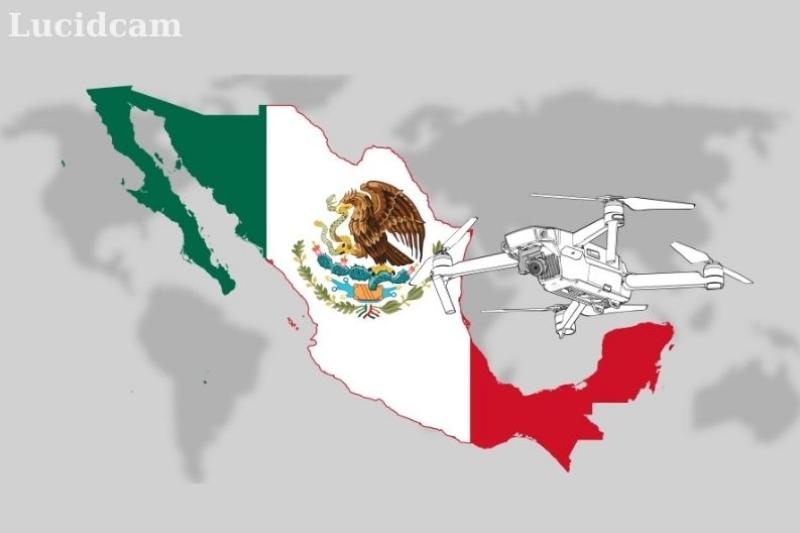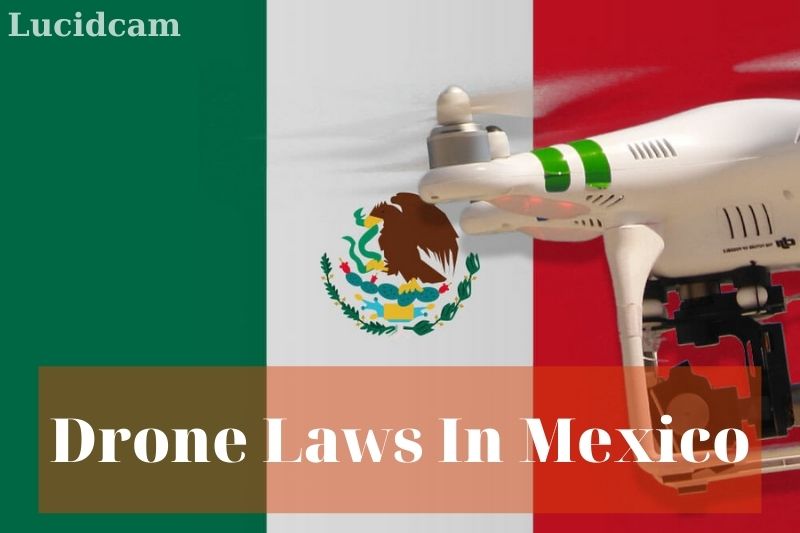Mexico is an excellent location for flying unmanned aerial vehicles (UAVs), commonly known as drones. Mexico has a tremendous quantity of geodiversity. It has rich tropical jungles, dry deserts, mountain ranges, and extensive lengths of coastline.
So, what are Drone Laws In Mexico? In this article, we will make clear that
Table of Contents
- 1 Mexico Drone Laws
- 1.1 General Rules for Flying a Drone In Mexico
- 1.2 Mexico’s New Regulations For Commercial Drone Operations
- 1.3 These Are The Top Drone Rules For Flying In Mexico.
- 1.4 Notes On How To Operate Commercial Drone Services In Mexico
- 1.5 Some Rules For Mexican Citizens Who Want To Fly Drones Legally.
- 1.6 Flying Drone Legally in Mexico: Tips
- 1.7 Register your drone
- 1.8 Fly during daylight hours
- 1.9 Stay within visual line of sight
- 1.10 Don’t fly over people or animals
- 1.11 Avoid restricted airspace
- 1.12 Follow INAH guidelines for filming
- 2 Penalties and Fines For Violating Drone Regulations in Mexico
- 3 FAQs
- 4 Conclusion
Mexico Drone Laws

General Rules for Flying a Drone In Mexico
Flying a drone in Mexico can be an exhilarating experience, but it’s crucial to follow the rules and regulations to ensure the safety of individuals and property. Here are the most important general rules to keep in mind:
- Only Mexican citizens are permitted to fly drones in the country as foreign persons are prohibited from registering their drones with the DGCA, which is mandatory for all drones weighing over 250 grams (.55 pounds).
- All drones weighing over 250 grams (.55 pounds) must be registered with the DGCA. Registration requires an official ID proving Mexican citizenship, and there is no provision for foreigners to register their drones.
- Drones must only be flown in daylight conditions to ensure visibility.
- The drone must be within the operator’s visual line of sight and no further than 1,500 feet away from the operator.
- Do not fly the drone higher than 400 feet above ground level to prevent interference with manned aircraft.
- Avoid flying over people or animals to avoid causing harm to them or endangering their safety.
- Do not fly drones over historical sites such as Chichen Itza, as it can damage the site and disrupt tourists.
- Drones must remain 9.2 kilometers (5 nautical miles) away from any aerodrome to avoid interference with manned aircraft.
- Do not exceed the maximum operating speed for the drone based on its maximum takeoff weight to ensure safe and controlled operation.
- Drones must not drop objects that may cause damage to people or property.
- It’s essential to follow the drone policies for the hotel or resort at which you are staying to avoid disturbing other guests.
- For professional or commercial purposes, permission is required to take photographs, film, or record in areas, monuments, and museums of the National Institute of Anthropology and History. There is also a large fee for taking photos or videos in INAH areas, up to $10,905.00 mxn/day. To apply for permission, you will need to provide a script, storyboard, or dummy sketch, a written document addressed to the National Coordination of Legal Affairs with a brief synopsis of the project and an application form INAH-01-001.
- Commercial drone operators are required to obtain a license to fly a drone in Mexico. The requirements for obtaining a license include being at least 18 years old, being Mexican by birth, providing your military release card, having a high school diploma, and being in good health.
Mexico’s New Regulations For Commercial Drone Operations
Commercial drone use is becoming increasingly popular among Mexican businesses. Multiple Mexican publications state that commercial drone pilots will need a license to fly drones in Mexico. These regulations will take effect on December 1, 2018.
The DGCA has yet to provide information about how to get a license. This page will be updated as soon as more information becomes available. We know that you need to:
- At least 18 years of age
- Mexican citizenship is possible by birth
- Your military release card must be presented
- A high school diploma is required
- Be in good health
This document contains legislation from Mexico that provides more information about Mexico’s drone laws.
These Are The Top Drone Rules For Flying In Mexico.

Mexican drone laws classify drones into three categories:
- UAVs of this size are 2 kg (4.4 pounds) or smaller. Although micro UAVs are allowed to fly without authorization from A.A., the commercial activity requires third-party liability insurance. They can be flown as high as 400 feet above the ground and as far away from the operator as possible within their visual line of sight.
- UAVs Light: These UAVs weigh between 2 and 25 kg (55 pounds). Only light UAVs can be flown by a club that is recognized for their recreational use. Light UAVs used for commercial purposes must have license plates and be registered with DGAC. Each commercial UAV flight must also be approved by the A.A. before it can be flown.
- UAVs that are heavy: These UAVs weigh more than 25 kg. All rules applicable to heavy drones must be followed. The DGAC also approved terms and conditions for heavy UAVs. A pilot’s license is required for heavy UAV operators.
Each weight class is strictly regulated for commercial and recreational use.
Except for a written exception granted by the FAA, operations are only permitted in daylight.
All UAVs must remain 9.2 kilometers (5.72 mi) away from controlled airfields, 3.7 kilometers (2.53 miles) away from uncontrolled airfields, and 900 meters (985 yards) away from helicopter pads.
UAVs cannot drop objects that could cause property or people damage.
UAVs can’t be flown above people or animals.
Operators, whether they are individuals or corporations, must respect all laws and regulations, federal and local.
UAV pilots must maintain direct eye contact (line of sight), with their UAVs.
Notes On How To Operate Commercial Drone Services In Mexico
Operating commercial drone services in Mexico requires adherence to certain rules and regulations. The Federal Civil Aviation Law and its Regulations are the primary legal instruments that govern the use of drones for commercial purposes in Mexico. Here are some notes on how to operate commercial drone services in Mexico:
- Obtain the necessary licenses and permits: Commercial drone operators must obtain a license from the Mexican Civil Aviation Authority (DGAC) before conducting any aerial work. Additionally, operators must obtain permits from the Secretariat of Communications and Transportation (SCT) and the Secretariat of National Defense (SEDENA) for specific flight operations.
- Register your drone: All drones used for commercial purposes must be registered with the DGAC. Operators must provide the make, model, and serial number of the drone, along with proof of ownership, liability insurance, and the drone pilot’s license.
- Hire licensed drone pilots: Commercial drone services must employ licensed drone pilots. The DGAC issues pilot licenses for different categories of drones based on their weight and capabilities.
- Follow the flight restrictions: Commercial drone services must abide by the flight restrictions outlined in the Federal Civil Aviation Law and its Regulations. These include flying within visual line of sight, below 400 feet above ground level, and not over people or congested areas.
- Ensure safety measures: Commercial drone operators must take adequate safety measures, such as conducting pre-flight inspections, maintaining a safe distance from obstacles, and avoiding hazardous weather conditions.
- Obtain permission for specific operations: Commercial drone services must obtain permission from relevant authorities for specific operations, such as flying in controlled airspace, conducting night flights, or flying over protected areas.
- Respect privacy laws: Commercial drone operators must respect privacy laws and obtain consent before collecting any personal data or conducting surveillance activities.
Start your application process online here. You will complete the application at the INAH service offices.
Some Rules For Mexican Citizens Who Want To Fly Drones Legally.
If you are a Mexican citizen who wants to fly drones legally, there are some important rules you must follow. Here are the main points to keep in mind:
- Weight restrictions: Drones weighing over 250g must be registered with Mexico’s Agencia Federal de Aviacion Civil, and you must have a valid government ID to register.
- Weather: Drone pilots must fly in ideal weather conditions. Flying in rainy or windy conditions is dangerous and could cause serious damage.
- Hours: Drone usage is restricted to daytime hours only for safety reasons.
- Height: Drones cannot fly higher than 121 meters above the ground unless you obtain permission from the AFAC.
- Restricted airspace: You cannot fly drones near military bases or airports, as this can result in a swift response from law enforcement and even arrest.
It’s important to note that these rules are in place to ensure the safety of both the drone operator and the public. By following them, you can enjoy flying your drone in Mexico without risking any legal trouble.
Flying Drone Legally in Mexico: Tips

If you want to fly your drone legally in Mexico, there are a few tips you need to keep in mind. These will help ensure you don’t run afoul of the country’s regulations.
Register your drone
If your drone weighs more than 250g, you need to register it with the Agencia Federal de Aviacion Civil. You’ll need to provide proof of Mexican citizenship and a valid government ID to register. Once registered, you’ll receive a unique identification number that must be displayed on your drone.
Fly during daylight hours
Mexico requires drone pilots to fly only during daylight hours. This is a safety precaution, as it’s difficult to fly a drone safely in low-light conditions. Keep in mind that sunset and sunrise times can vary significantly depending on your location in Mexico.
Stay within visual line of sight
To fly your drone legally in Mexico, you need to maintain visual line of sight (VLOS) at all times. This means you must be able to see your drone with your naked eye, without the aid of binoculars or other devices. If you lose sight of your drone, you risk crashing it or violating regulations.
Don’t fly over people or animals
Mexico prohibits drone flights over people or animals, as it can be dangerous and disruptive to both. This also means you can’t use your drone to spy on people or invade their privacy.
Avoid restricted airspace
You can’t fly your drone near military bases or airports in Mexico, and there may be other areas designated as no-fly zones. Be sure to check the map and familiarize yourself with these restricted areas before you fly.
Follow INAH guidelines for filming
If you plan to use your drone for commercial purposes, you’ll need to follow guidelines set forth by the National Institute of Anthropology and History (INAH) for filming in certain areas. This may require obtaining permission and paying a fee.
By following these guidelines, you can enjoy flying your drone legally and safely in Mexico.
Penalties and Fines For Violating Drone Regulations in Mexico
In Mexico, violating drone regulations can lead to both civil and criminal sanctions. The severity of the penalty will depend on the nature of the offense and the level of risk posed to public safety. Some of the penalties and fines for violating drone regulations in Mexico are as follows:
- Civil Sanctions: Operators who violate drone regulations in Mexico may face civil sanctions such as fines, suspension or revocation of their operating license, or the confiscation of their drone. Civil penalties can range from 10,000 to 500,000 Mexican pesos, depending on the severity of the offense.
- Criminal Sanctions: In addition to civil sanctions, operators who violate drone regulations in Mexico may also face criminal charges. Criminal penalties can include imprisonment for up to 5 years or more, depending on the level of risk posed to public safety.
- Confiscation of Drones and Other Equipment: Mexican authorities have the right to confiscate drones and other equipment used to violate drone regulations. This includes any equipment used to operate the drone, such as cameras, controllers, and batteries.
- Liability for Damages Caused by Drones: Operators who violate drone regulations in Mexico may also be held liable for any damages caused by their drone. This includes damage to property, personal injury, or even death. Liability for damages can be significant, depending on the nature and extent of the harm caused.
Overall, the penalties and fines for violating drone regulations in Mexico are designed to discourage reckless or negligent behavior and to ensure the safety of the public. It is important for drone operators to be aware of these regulations and to comply with them at all times in order to avoid the potential legal and financial consequences of non-compliance.
FAQs
Can foreigners fly drones in Mexico?
The bad news is right at the start: foreigners cannot fly drones unless they have a special agreement signed with Mexico. Some exceptions are made for scientific reasons. The Defense Agency (Secretaria de la Defensa Nacional) must be granted permission.
Is it necessary to have a Mexican drone pilot’s license?
Mexico License for Commercial Drone Operators
To fly drones in Mexico, commercial drone operators must obtain a license. To obtain a drone license in Mexico, you must be at minimum 18 years of age.
Can I take a drone with me onboard a plane?
You can check your drone in or bring it along when you travel by plane. It is possible to bring your Spark onboard if you are flying with it. No matter how many times you check your drone’s batteries, do not put them in a bag.
Are drones allowed in Cancun?
All foreign nationals, including those from the U.S., are now prohibited from flying drones in Mexico since December 1, 2018. This applies to Cancun as well as Cozumel. To fly a drone in Mexico, you must register with the DGCA. Only Mexican citizens are allowed to register.
Conclusion
To the best of our knowledge, we have reviewed the Mexican drone regulations. The accuracy of the information is not guaranteed. For your safety, you should contact the relevant aviation authority. You can also contact the embassy of your country to get more information. We will love to hear from you if you have any news or experience with your copter while in Mexico.
You can read Pennsylvania Drone Laws 2023: Top Full Guide or Philippines Drone Laws 2023: Top Full Guide. and others, if you want to know more information before flying a drone.
